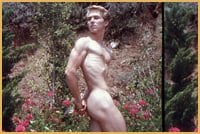Unlike sequins and drag queens, erotic photographs and 3-D glasses aren’t the most obvious of pairings.
In fact, if anyone’s going to wear 3-D glasses in 2008, chances are it will be for a children’s action movie or the screening of a cult classic that features an oversized reptile.
3-D is silly, fun, slightly campy — qualities we don’t ordinarily seek when viewing erotic images of naked bodies. That wasn’t always the case, though.
Well before the years of downloadable digitized images, videotape and 8mm film, there was stereoscopic photography — a medium whose special lenses allowed viewers to flesh out the ho-hum flatness of ordinary snapshots and obtain life-like richness of depth.
In 1947, a new model of portable stereoscopic camera came on the market. One was purchased — and subsequently used several thousand times — by Denny Denfield, an accountant with the US Army whose erotic experiences in the South Pacific during WWII had inspired him to become a photographer whose portraits would capture and preserve various embodiments of masculine beauty.
A modestly-sized sampling of Denfield’s massive collection can now be seen in David L Chapman and Thomas Waugh’s Comin’ at Ya! (Arsenal Pulp Press $32).
Viewed through 3-D glasses (each volume includes one sturdy pair), the photos and their impressive illusion of depth may prove titillating for many. Despite the allure, I found myself scrutinizing these strangers and the tableaus in which they stood, sprawled or reclined, wondering about the queer lives led in a bygone era.
And bygone the era seems. As Chapman notes at the beginning of his book’s affable introduction: “Before the 1970s, all sexually explicit art was dangerous.”
Risking disapproval from his strong-willed mother and, worse, censure from his conservative and powerful employer, Denfield (a man “consumed by self-doubts and inner demons,” according to Chapman) photographed a huge assortment of men in his residence in San Francisco or at nearby parks and beaches. Ranging from wholesome exteriors (posed naturalist beach shots) to randy interiors (drunk and disorderly sex party scenes), the photos hint at the great divide between public and private behaviors in Denfield’s time.
Denfield considered the photos a private collection, though one he kept carefully stashed away in his attic until his mother died in 1960. He refused to sell any, even to the likes of admirers like Rock Hudson. Upon Denfield’s death in 1992, two collectors, who happened to be Chapman’s friends, purchased the set.
As Chapman talks about gay history, pioneering gay artists, erotic art and vintage photograph collectors at the quiet café in Seattle’s Frye Art Museum, it’s not long before his soft-spoken and scholarly demeanor gradually fades to reveal another facet: the avid fan.
Having “amassed literally thousands of photos” over 30 years and published numerous books about them, Chapman can also easily recall the embarrassment he felt when — at 10 years of age — he bought his first Physique Pictorial magazine (in Los Angeles from a blind newsstand agent, so he had to say the title aloud).
For this collector it’s been an enduring infatuation.
But Chapman is no photographer.
“I’ve never picked up a camera in that way,” he reveals. “I know my talents. To talk about them, preserve, analyze, and arrange them, that’s what I do best,” he says.
A career-long high school social studies teacher by day, Chapman has devoted spare time and summers to authoring a diverse portfolio of publications, including a biography of the Victorian bodybuilder Eugen Sandow, a history of pre-WWII male physique pin-ups, two previous (but currently out of print) books on Denfield’s stereoscopic photos and a forthcoming history of jazz in Italy during the Fascist regime.
On the subject of publicizing material Denfield kept private and guarded closely, Chapman is initially blunt: “Well, he’s dead.”
“Of course I thought it over,” he adds. “Numerous times.
“By publishing the photos, I’m not going to hurt anyone. Denfield has no immediate family. No one else I spoke to, including former friends and models, had any problem with publication.
“And Denfield’s is a story that needs telling and the photos deserve a public audience. I think I did the right thing.”
Presenting Denfield’s “fugitive images” ensures that his work contributes to ongoing projects aimed at queer visibility, Chapman believes. “They’re a wonderful historical artifact,” he enthuses, “part of graphic history and gay history.”
“I see Comin’ at Ya! as a way of shedding light on a previously unknown corner of history.”
Of his own collection, Chapman — who possesses one of the world’s largest libraries of vintage male physique photographs — is not aiming for private appreciation. Instead, he’s aiming for accessibility.
“I want them to be available to use, to study, to look at.”
Chapman notes that, unlike Denfield, he’s “lucky enough to live at a time” with a relatively accepting political climate. He intends to take advantage of it, and display images that in another era would have been sequestered or destroyed.

 Why you can trust Xtra
Why you can trust Xtra


